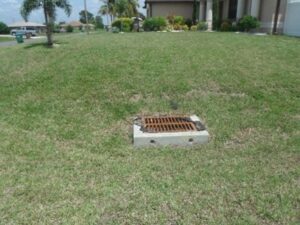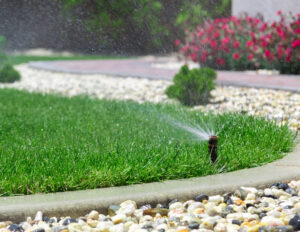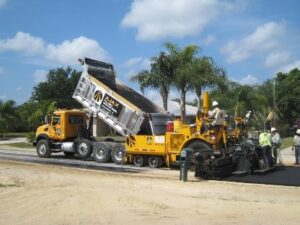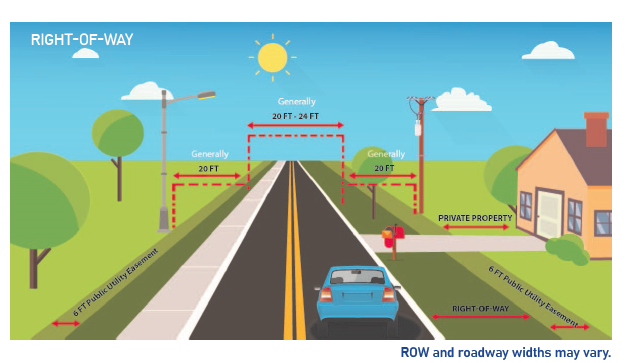Construction Process
What To Expect Before, During, and After Construction
Overview:
During the North 1 West UEP, contractors will follow a general phasing schedule, dependent on many factors including underground conditions, weather, and protected species avoidance and relocation. Three new pipelines will be installed: sewer, potable water, and irrigation. The new sewer lines will be placed in the center of the street, while potable water and irrigation lines will be placed within the right-of-way (ROW) on either side of the road. Stormwater pipes and catch basins will also be replaced within the ROW on both sides of the road to improve drainage along the roadway. Construction will be concurrent on multiple streets and will move around depending upon “shovel-ready” areas. Every effort will be made to minimize impacts, but residents and businesses should expect temporary inconveniences. Construction crews will work to maintain direct roadway access to residences and businesses as much as possible. During construction, please maintain a safe distance from construction areas and discourage children from approaching construction equipment or materials.
Here is a summary of what you can expect:
- Large trucks will transport pipes, supplies and construction equipment to staging areas utilizing vacant land or the road ROW.
- Asphalt roads will be removed.
- Dewatering pumps will be activated.
- Excavators will dig separate trenches for pipes.
- Crews will be on-site installing and covering pipes.
- Installed pipes will be tested.
- Roads will be rebuilt.
- Sod and irrigation in the ROW will
be restored at the completion of each section. - Mud, dust, noise, changes to traffic patterns can be expected.
A schedule will be posted on the project website, however, it is subject to change
Contractors are expected to work weekdays from 7:00 a.m. to 7:00 p.m., Monday through Friday. Some Saturday and night work may be necessary to complete emergency repairs, minimize disruption, or for time-sensitive work.
Before Construction
Identify City’s Public Right-of-Way (ROW)
Work will take place in the City’s Public ROW. When discussing exactly where construction will take place, it’s helpful to understand the term ROW. This term refers to property rights owned by a public entity and reserved for infrastructure. In Cape Coral, the ROW varies from street to street, but generally the City has ROW rights to approximately the first 20 feet from the edge of pavement. Survey crews will identify the ROW which typically coincides with the property line.
Personal Items in the ROW
Some personal property items located in the ROW may need to be removed or relocated out of the ROW during utility installation. Personal property items may include, but are not limited to, irrigation systems, lighting, landscaping, decorative fencing or walls, yard art, basketball hoops, and monument or decorative mailboxes. Large decorative/monument style mailboxes affecting construction may be removed by the contractor as work progresses; however, the contractor will not be responsible for damage to or for reinstalling these types of mailboxes. If you would like to preserve your large decorative/monument style mailbox, you should do so prior to construction moving to your area. Standard mailboxes will be removed and reinstalled as work progresses. Property owners can flag irrigation heads that are located within the ROW to alert the contractor of their location. The contractor will make every effort to work around the system; however, irrigation lines in the ROW will be cut and capped during construction if necessary.
If your property has items located within the ROW that are determined to be a conflict with construction, you will be notified in writing regarding the conflict. Typically, items within the ROW that present a conflict must be removed within 60 days of notification. If they are not removed, the contractor is authorized to remove and dispose of any of those items without replacement in the way of construction, per City Ordinance 83-93.
Underground Utilities
Prior to the start of construction, you may see survey crews in your neighborhood. These crews identify the ROW and the locations of underground utilities such as phone and cable conduits.
Working from data obtained by surveyors, the contractor, and utility operators, “811 Call Before You Dig” contractors will mark underground utilities in the work zone with colored flags. This helps ensure remaining underground lines are not damaged during construction and existing utility service to your residence remains uninterrupted. Please do not attempt to remove these flags.
Preconstruction Videos
Videographers will record existing conditions of the project area, including items in the ROW prior to the start of construction. This helps to protect all parties if disputes arise during and after construction.
Erosion Control
Silt fencing is a porous fabric that will be installed along the edges of construction throughout the project for erosion control. Protective floating turbidity barriers will also be installed in canals to block silt and sediment caused from construction.
Preparation Of The Construction
Asphalt Roadway
Asphalt will be removed to install sewer pipes. 2. The road near your house or business will be without asphalt for several months. While under construction, the roadways will be functional and maintained. All efforts will be made to control excessive dust and mud in the project area. Access to your home or business will be maintained, but temporary road closures and detours around the work area will be necessary at times.
Note: Roads will remain without asphalt until all three pipelines are installed and the pipe testing is completed.
Dewatering
The process of installing the new underground utilities will require the use of multiple dewatering pumps to remove groundwater from the pipe trench. The pumps will need to run 24 hours a day and can be noisy. The contractor will make every effort to place the pumps in areas that are the least intrusive to residential properties; however, the location of these pumps will be determined by construction activities and may not be adjustable. The pumps will move as pipe installation progresses.

Dewatering Pipes

Dewatering Pumps

Dewatering Pipes
During Construction
Road Closures and Detours
Road closures and detours will be necessary to construct the project and ensure the safety of the construction crews and motorists. Detours will be clearly marked with signs and updates will be available through the WAZE app as we are notified by the contractors or as it occurs in the field. Major road detours and closures will be posted on the Traffic Advisory section of the project website.
Grass (Sod) and Driveway Removal
To prepare for irrigation and potable (drinking) water pipe installations, sod and driveway aprons within the ROW will be removed. The contractor will water sod initially to encourage root growth. After that, it is the homeowner’s responsibility to maintain their sod. Driveway aprons and sod will be restored by contractors during the restoration phase. Sod will be restored to match the existing sod on private property. Specialty driveways (painted, stamped, pavers) could be replaced with new material and, therefore may have a slight color difference from the existing driveway due to exposure to sun and weather.
Mail and Trash
A construction representative will attempt to notify residents at home at least one day in advance of construction activities that may affect property access. Standard mailboxes may temporarily be removed or relocated, and trash service disrupted. Construction representatives will coordinate with the U.S. Postal Service and Waste Pro to ensure these services continue with minimal disruption.
Lateral Pipes
The newly installed pipes will be different colors and sizes, depending on their function. Contractors will typically install sewer pipes down the middle of the roadway, while potable (drinking) water pipes and irrigation pipes will be installed within the grassed area of the ROW.

Sewer Pipes

Water Pipes

Irrigation Pipes

Stormwater Pipes
Road Closures and Detours
Road closures and detours will be necessary to construct the project and ensure the safety of the construction crews and motorists. Detours will be clearly marked with signs and updates will be available through the WAZE app as we are notified by the contractors or as it occurs in the field. Major road detours and closures will be posted on the Traffic Advisory section of the project website.
Grass (Sod) and Driveway Removal
To prepare for irrigation and potable (drinking) water pipe installations, sod and driveway aprons within the ROW will be removed. The contractor will water sod initially to encourage root growth. After that, it is the homeowner’s responsibility to maintain their sod. Driveway aprons and sod will be restored by contractors during the restoration phase. Sod will be restored to match the existing sod on private property. Specialty driveways (painted, stamped, pavers) could be replaced with new material and, therefore may have a slight color difference from the existing driveway due to exposure to sun and weather.
Mail and Trash
A construction representative will attempt to notify residents at home at least one day in advance of construction activities that may affect property access. Standard mailboxes may temporarily be removed or relocated, and trash service disrupted. Construction representatives will coordinate with the U.S. Postal Service and Waste Pro to ensure these services continue with minimal disruption.
Lateral Pipes
The newly installed pipes will be different colors and sizes, depending on their function. Contractors will typically install sewer pipes down the middle of the roadway, while potable (drinking) water pipes and irrigation pipes will be installed within the grassed area of the ROW.
Potable (Drinking) Water System Installation
The City’s contractor will install water service pipes, along with meter boxes in the ROW. Once the project is complete, property owners will need to contact their own plumber to install the meter and connect these lines to their home. More information on Potable Water System Installation is included on pages 15 and 16 of this packet.
Service Lines to House or Business
Once the water, sewer and irrigation pipes are installed under and along the roadway, the City’s contractor will then install service lateral pipes. These lateral pipes will connect the main pipes to the meter boxes, which will be installed in the ROW for future connectivity.
Wastewater System Installation
Sewer systems transport wastewater from houses and businesses to treatment facilities. The new sewer pipes will typically be located under the center of the roadway. To install the pipes, trenches will be dug in the center of the roadway after the asphalt is removed. Pipes will generally be installed underground between 5 feet to over 20 feet in depth. This process requires the use of heavy machinery and restricts traffic flow through the work zone. Service lines will be extended to the ROW at each property for future connection by the property owner.
Catch Basins
Existing open throat catch basins are being replaced with raised grate inlets with 3-inch diameter openings. These openings increase the storage and treatment of stormwater within roadway swales. This change brings about a multitude of positive impacts to stormwater quality benefiting the adjoining canals and shorelines.

Raised Grate Inlet
Irrigation Water System
Installation
Reclaimed or recycled water irrigation systems will transport highly treated reclaimed water to homes for use as landscape watering only. Irrigation pipes are purple in color and will be installed in the ROW parallel to the roadway.

Irrigation
Fire Hydrants
Installation of fire hydrants in the area will provide a fire protection system with a reliable water supply and pressure.

Fire Hydrants
Air Release Valve
Air release valves will be installed throughout the system. These valves release air that builds up in the pipes, which can restrict flow.

Air Release Vavle
System Testing
Testing of the overall pipeline system will occur before the road is rebuilt. This is to ensure the system is safe and operational before the asphalt is placed over the new pipelines. During this time, there may be less construction activity while system testing is being conducted at various locations throughout the neighborhood.
Restoration
Road Replacement
As the project approaches completion, crews will rebuild and repave the roads.

Paving
Road replacement includes several steps:
- Crews prepare the surface by leveling it with grading equipment
- Aggregate base is placed evenly on the road surface
- Asphalt primer is placed in layers on top of the base
- Black tack surface is placed on top of the asphalt primer
- Permanent skid resistant asphalt is placed
- Roadway markings are painted on the road
Drainage Improvements
Once the pipes are installed, the ditches along the roadway will be graded and swales will be constructed. This system will provide necessary stormwater drainage for the roadway.
Driveways, Grass, Sprinkler Systems, Mailboxes
When testing is complete and construction crews have removed most of the large equipment, the final restoration process will begin. This includes rebuilding driveways, installing sod, resetting mailboxes, and making repairs due to construction.



